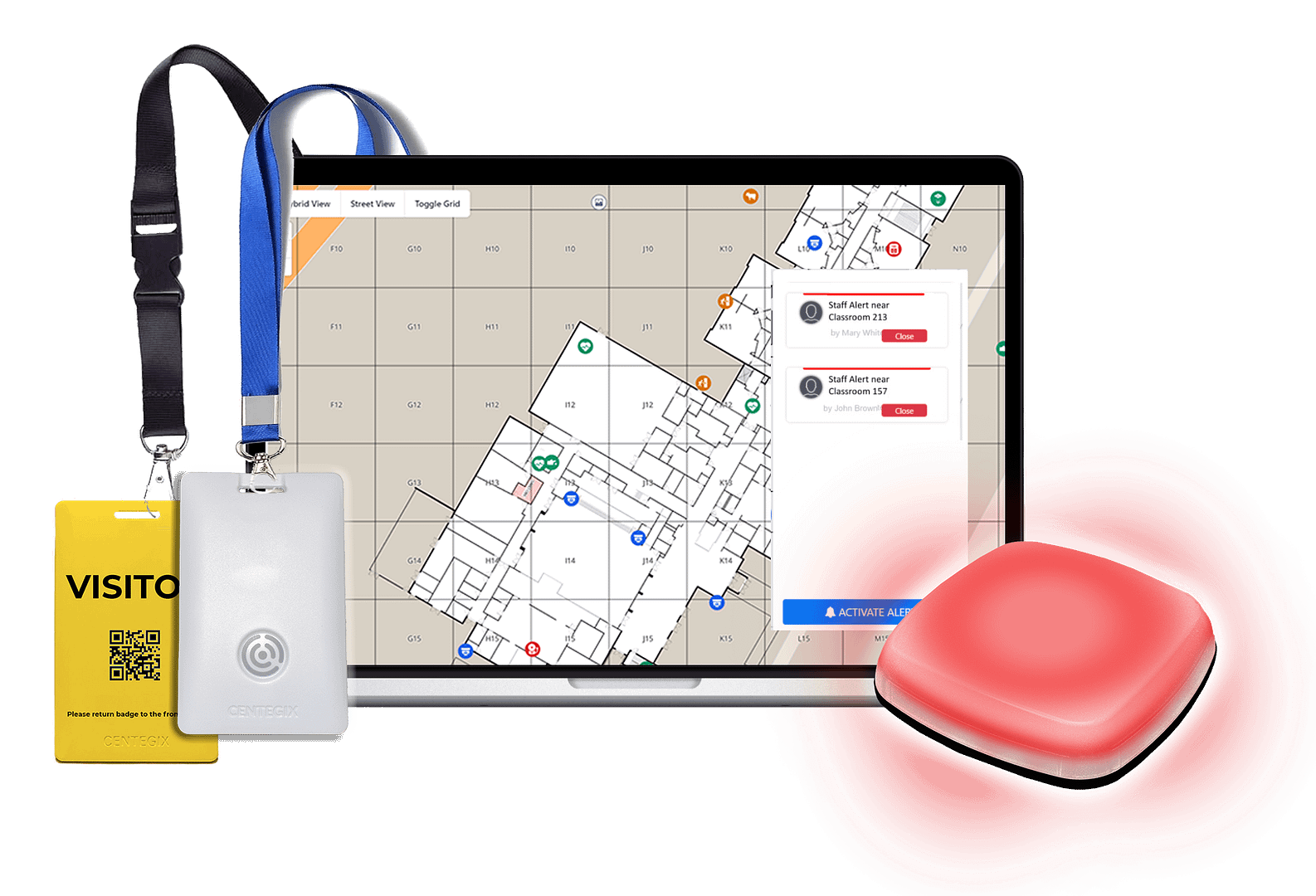Following the May 2022 mass shooting at Robb Elementary School in Uvalde, Texas, lawmakers instituted measures to prevent similar tragedies. Investigations after the incident revealed “systemic failures,” including lapses in essential communications. To prevent these failures in the future, the Texas legislature approved the distribution of grants to Texas schools for safety and security measures. A cost-effective way for Texas districts to ensure seamless communication during times of crisis is to implement a school safety plan that includes effective silent panic alert technology (SPAT). This improved incident response technology can save lives and prevent tragic outcomes. Texas education leaders should invest in school safety solutions that are easily adopted, reliable, and empower school staff to respond to crises.
Robb Elementary Investigation Reveals Systemic Failures
The mass shooting at Robb Elementary School is one of many instances of school violence in Texas. Historically, Texas has ranked high among all states in the number of incidents and threats of school violence. In 2018, the state ranked fourth in the number of incidents and seventh in the number of threats. During the 2021-2022 school year, schools across Texas reviewed more than 67,000 reports of potentially violent students. In July 2022, the Texas House of Representatives published the Robb Elementary Investigative Committee Report. The report summarizes the events leading up to the Uvalde shooting, the shooter’s actions, the safety and security measures in place at the school, and the law enforcement response. It also offers several preliminary conclusions about how and why the incident resulted in so many casualties. First among these conclusions is that a communication breakdown prevented staff members from knowing what was happening in their building. According to the report, poor wi-fi connectivity in Robb Elementary delayed the web-based security application’s lockdown alert. Poor wi-fi service also prevented some teachers from receiving the initial alert immediately. In addition, some teachers did not have their phones on their person at the time of the alert. Because Robb Elementary used an app-based solution, staff members’ awareness of the alert depended on them having their phones on their person.
Texas Lawmakers Fund School Safety Solutions

Improve school safety plan
Texas lawmakers responded to the tragedy in Uvalde by instituting a host of school safety solutions and security initiatives. In October 2022, Texas officeholders, including Governor Greg Abbott, announced that the state would spend $874.6 million on public safety initiatives. Of this money,
- $400 million will assist school districts in replacing or upgrading doors, windows, fencing, communications, and other safety measures.
- $15 million will assist in the construction of a new elementary school in Uvalde.
These funds were distributed to Texas districts through grants based on student enrollment. The minimum grant amount is $200,000. As a result of this state funding, Texas schools will have more resources to make security improvements and institute new school safety solutions. For most districts, a specialized SPAT system will form the centerpiece of their security spending. According to reporting in the Austin American-Statesman, required panic alarm systems must include a panic button that “notifies all staff and school administrators, which would then alert law enforcement agencies of emergencies.” If campuses have electronic door locking systems, the SPAT system must also lock all doors and send notifications if doors remain unlocked.
School Safety Standards Formula Grant
The 2023-2025 School Safety Standards Formula Grant includes money for schools to purchase new SPAT systems. The grant specifies that it will fund the purchase of “technology, including communications systems or devices, that facilitates communication and information sharing between students, school personnel, and first responders in an emergency.” The School Safety Standards Formula Grant allows spending on various security-related items identified by each Local Education Agency (LEA) but specifies that funds must first be spent on items necessary to comply with the School Safety Standards Rule. Once districts meet the rule’s standards, the remaining funds can be spent on other eligible security-related costs defined in the grant’s allowable costs. The grant allows spending on:
- Purchase and installation of SPAT
- Maintenance/service contracts for SPAT systems
- Purchase of comprehensive school safety software systems if SPAT is a primary component (50% or more of the total cost) of the comprehensive system
- Local Educational Agency (LEA) personnel costs associated with the installation of SPAT
- Lease purchase of SPAT if completely paid within the grant period
The School Safety Standards Rule also requires schools to conduct weekly maintenance checks of exterior door locks and twice-yearly maintenance checks of all safety infrastructure. Texas school districts should anticipate that additional requirements and supports will be forthcoming. Lawmakers, the Texas Education Association (TEA), and the Texas School Safety Center are developing additional actions to improve school safety, including:
- expanding technical assistance for emergency operations plan development
- conducting threat assessment protocols
- expanding the availability of school-based law enforcement
- improving drills and incident preparedness exercises
- supporting LEA efforts to implement multi-tiered systems of support for these measures
Silent Panic Alert Technology Grant

Improve school safety plan
A second grant, the 2022-24 Silent Panic Alert Technology Grant, provides funding specifically for LEAs to purchase SPAT systems. The grant specifies that SPAT is generally defined as “a silent system signal generated by the activation of a device, either manually or through software applications, intended to signal a life-threatening emergency (such as an active shooter, intruder, or another emergency) requiring a response from law enforcement and/or other first responders.” The School Safety Standards Rule seeks to fund “school system communications infrastructure.” The TEA specifies that this infrastructure shall include a panic alert button, duress, or equivalent alarm system. The system can utilize standalone hardware or be integrated into other telecommunications devices and must have the following functionality:
- Campus staff can trigger alerts manually.
- 911 calls trigger an automatic alert from any location.
- The system reports the location of any alert.
- The alert notifies designated school administrators for confirmation.
- Confirmed alerts can be issued simultaneously to first responders and school staff.
- The alert system triggers the electronic locking of exterior doors and notifies relevant staff of any door where the lock cannot engage.
CENTEGIX CrisisAlertTM: the Premier SPAT System
To be effective, SPAT must have 100% user adoption, be user-friendly, and report the precise incident location. The CENTEGIX CrisisAlert system precisely fulfills all of the Texas grant requirements for making school campuses safer and more secure; it is an essential investment for any district. As a critical element of a school safety plan, CrisisAlert helps school districts address the challenge of school violence in a seamless way that contributes to a culture of safety on campus. A critical advantage of CrisisAlert is its unique technology. The CrisisAlert system runs on its own network, which eliminates problems posed by unreliable wi-fi networks. CrisisAlert requires no wi-fi or cellular signal to send an alert. Automatic phone and digital notifications are sent to 911 first responders within seconds. And because every staff member has a discreet wearable emergency button, the adoption rate is 100%. So anyone can call for help at any time, from anywhere on campus.
CrisisAlert is a “Game Changer” in Florida
CENTEGIX CrisisAlert has been implemented in many school districts across the country. In Hillsborough County, Florida, Hillsborough Public Schools’ Chief John Newman called the CrisisAlert school safety solution a “game changer.” According to Newman, “some of our campuses are over 40 acres. They’re huge facilities. And to be able to pinpoint where the threat is and where the assistance needs to go is a game changer in school security.” CrisisAlert technology prevents the confusion that delayed response times in Uvalde. Because the wearable panic button pinpoints the location of alerts, responders know exactly where to go. In February 2021, the Florida Department of Education (DOE) approved the CENTEGIX CrisisAlert solution for school districts to comply with Alyssa’s Law. This law, implemented after the 2018 school shooting in Parkland, Florida, required that every school staff member be equipped to activate an emergency alert. CrisisAlert is the only badge-based solution approved by the DOE. Florida teachers and school staff overwhelmingly reported that CrisisAlert is easy to use and that it makes them feel safer and more supported. CrisisAlert is the right school safety solution to prevent lapses in communication during emergencies of all kinds. In addition, it helps schools meet new legislative requirements aimed at keeping students safe. CENTEGIX is the leader in incident response solutions. Our CrisisAlert platform is the fastest and easiest way for staff to call for help in any emergency, from the everyday to the extreme. CENTEGIX creates safer spaces by innovating technology to empower and protect people, and leaders nationwide trust our safety solutions to provide peace of mind. To learn more about CENTEGIX, visit www.centegix.com.










